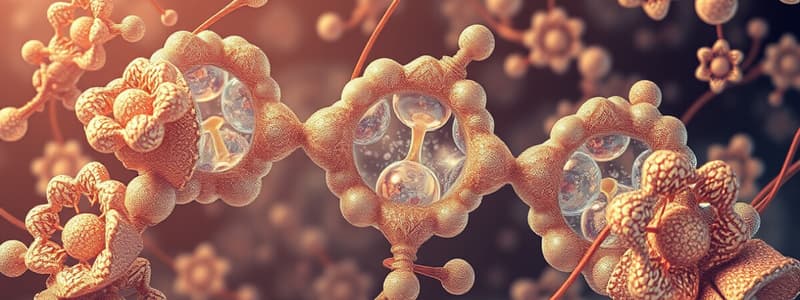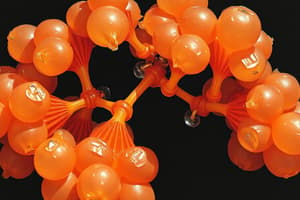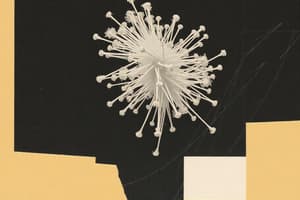Podcast
Questions and Answers
What type of ring structure is present in steroidal compounds with a cardinolide type?
What type of ring structure is present in steroidal compounds with a cardinolide type?
- 5-membered unsaturated lactone ring (correct)
- 6-membered unsaturated lactone ring
- 6-membered lactone ring
- 5-membered saturated ring
Substitutions in R1 and R2 lead to the same types of aglycones.
Substitutions in R1 and R2 lead to the same types of aglycones.
False (B)
What functional groups are present at C3 and C14 in the steroidal nucleus described?
What functional groups are present at C3 and C14 in the steroidal nucleus described?
hydroxyl groups (–OH)
The structure described features a steroidal nucleus with a hydroxyl group at C3 and a hydroxyl group at C14, along with a 5-membered unsaturated _____ ring.
The structure described features a steroidal nucleus with a hydroxyl group at C3 and a hydroxyl group at C14, along with a 5-membered unsaturated _____ ring.
Match the terms related to steroidal compounds to their correct descriptions:
Match the terms related to steroidal compounds to their correct descriptions:
What is formed when an aldehyde reacts with an alcohol?
What is formed when an aldehyde reacts with an alcohol?
Sucrose is classified as a heteroside.
Sucrose is classified as a heteroside.
What type of bond is formed between two sugar molecules during the formation of sucrose?
What type of bond is formed between two sugar molecules during the formation of sucrose?
The structure of glucose in an open chain form is called __________.
The structure of glucose in an open chain form is called __________.
Match the following glycosidic bonds to their corresponding characteristics:
Match the following glycosidic bonds to their corresponding characteristics:
Which of the following statements about glucopyranose is true?
Which of the following statements about glucopyranose is true?
The acetal bond is involved in the structure of starch.
The acetal bond is involved in the structure of starch.
What type of glycoside bond involves phenolic structures?
What type of glycoside bond involves phenolic structures?
What is the main cardinolide found in Strophanthus kombi?
What is the main cardinolide found in Strophanthus kombi?
Digitalosmine is derived from the dried seeds of Strophanthus kombi.
Digitalosmine is derived from the dried seeds of Strophanthus kombi.
Name the family to which Strophanthus kombi belongs.
Name the family to which Strophanthus kombi belongs.
The aglycone of k-strophanthoside is called ______.
The aglycone of k-strophanthoside is called ______.
Match the following terms with their corresponding descriptions:
Match the following terms with their corresponding descriptions:
What condition may lead to myocardial infarctions affecting left ventricular function?
What condition may lead to myocardial infarctions affecting left ventricular function?
Heart muscle diseases do not impact left ventricular function.
Heart muscle diseases do not impact left ventricular function.
Name one type of disease that affects the heart muscle.
Name one type of disease that affects the heart muscle.
____ is a disease that leads to damage of the heart muscle and affects ventricular function.
____ is a disease that leads to damage of the heart muscle and affects ventricular function.
Match the following conditions to their effects on the heart:
Match the following conditions to their effects on the heart:
Which functional group is present in the structure depicted by COOH?
Which functional group is present in the structure depicted by COOH?
The structure represented by COOH is a type of hydrocarbon.
The structure represented by COOH is a type of hydrocarbon.
What is the chemical formula for a quinone structure with a carboxylic acid group?
What is the chemical formula for a quinone structure with a carboxylic acid group?
The presence of a carboxyl group in a compound generally increases its ________ in water.
The presence of a carboxyl group in a compound generally increases its ________ in water.
Match quinone related terms with their properties:
Match quinone related terms with their properties:
Flashcards
Cardenolide Ring Structure
Cardenolide Ring Structure
Steroidal compounds with a cardenolide type feature a 5-membered unsaturated lactone ring.
Steroidal Hydroxyl Groups
Steroidal Hydroxyl Groups
Hydroxyl groups (-OH) are present at C3 and C14 in the described steroidal nucleus.
Hemicetal Formation
Hemicetal Formation
A hemicetal is formed when an aldehyde reacts with an alcohol.
Sucrose Classificiation
Sucrose Classificiation
Signup and view all the flashcards
Acetal Bond Formation
Acetal Bond Formation
Signup and view all the flashcards
Open Chain Glucose
Open Chain Glucose
Signup and view all the flashcards
Glucopyranose Structure
Glucopyranose Structure
Signup and view all the flashcards
Acetal Bond in Starch
Acetal Bond in Starch
Signup and view all the flashcards
Acetal Glycoside Bond
Acetal Glycoside Bond
Signup and view all the flashcards
K-strophanthoside
K-strophanthoside
Signup and view all the flashcards
Digitalosmine Source
Digitalosmine Source
Signup and view all the flashcards
Strophanthus Family
Strophanthus Family
Signup and view all the flashcards
k-strophanthoside Aglycone
k-strophanthoside Aglycone
Signup and view all the flashcards
Ischemic Heart Disease
Ischemic Heart Disease
Signup and view all the flashcards
Heart Muscle Diseases
Heart Muscle Diseases
Signup and view all the flashcards
Heart Muscle Disease
Heart Muscle Disease
Signup and view all the flashcards
Ischemic Heart Disease Effects
Ischemic Heart Disease Effects
Signup and view all the flashcards
COOH Functional Group
COOH Functional Group
Signup and view all the flashcards
Carboxylic Acid as Hydrocarbon
Carboxylic Acid as Hydrocarbon
Signup and view all the flashcards
Quinone Structure Formula
Quinone Structure Formula
Signup and view all the flashcards
Carboxyl Group Solubility
Carboxyl Group Solubility
Signup and view all the flashcards
Study Notes
Glycosidic Bonds
- Glycosidic Linkage: Formation between carbohydrates and other compounds, involving hydroxyl (OH) groups.
- Types of Bonds:
- Hemicetal bond: Formed between an aldehyde and alcohol.
- Acetal bond: Results from the reaction of two alcohols with a hemiacetal.
Glucose Structures
- Open Chain Glucose: Linear form with aldehyde (CHO) at one end, and hydroxyl groups (-OH) attached to carbon atoms.
- Folded Glucose: Exists in cyclic forms such as glucopyranose (six-membered ring) and glucofuranose (five-membered ring).
Types of Carbohydrates
- Holoside: Disaccharides such as sucrose formed through acetal bonds.
- Heteroside: Composed of an aglycone and a glycone, e.g., in terpene or phenolic glycosides.
Sucrose Composition
- Disaccharide Structure: Comprised of glucose and fructose, connected by an acetal bond.
Glycoside Variants
- Types of Glycoside Bonds:
- Steroidal nucleus with β-hydroxyl groups at C3 and C14.
- Formation of 5-membered unsaturated lactone rings, characteristic of cardinolides.
Aglycone Derivatives
- R Group Substitutions: Changes in R1 and R2 provide different aglycones, influencing pharmacological activity, such as the presence of amino acids.
Strophanthus Seeds
- Cardinolides: Extracted from Strophanthus kombi which contains k-strophanthoside affecting heart muscle function.
- Health Implications: Commonly used in treating ischemic heart diseases which can lead to myocardial dysfunction.
Additional Structures
- Quinones: Notable for having carboxyl (-COOH) groups and a conjugated double bond system, contributing to their reactive nature.
Studying That Suits You
Use AI to generate personalized quizzes and flashcards to suit your learning preferences.





